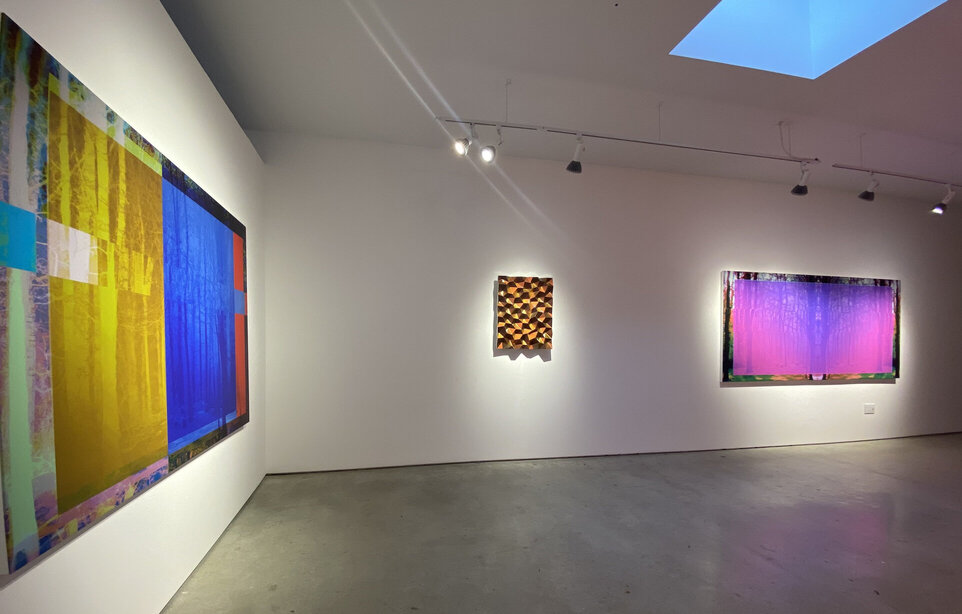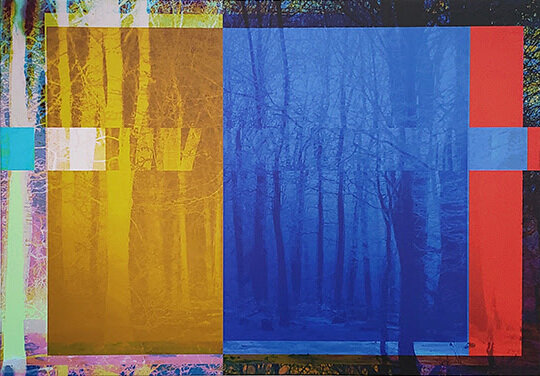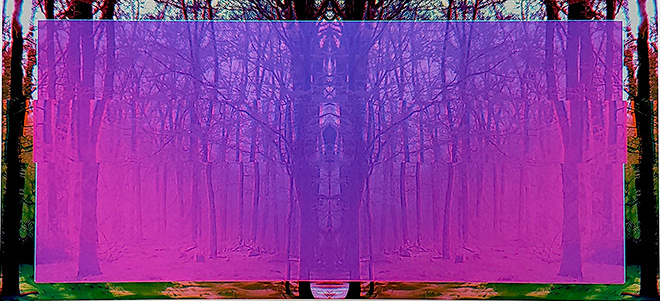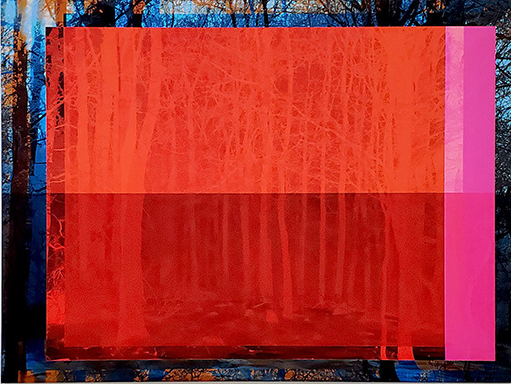On a grey October day, colour was mostly drained from the city as it prepared for winter hibernation. How glorious it was then, to come upon Christian Eckart’s work at General Hardware Contemporary. The paintings are so bright, so saturated, that they illuminate the walls and ceiling with reflected colour.
Three large artworks depict forest scenes that have been digitally distorted and overlaid with bright rectangular fields of colour. Photos of the work do not do justice to the density and intensity of colour that these paintings project.
I describe them as paintings. A stickler may quibble. Paintings? They are not made with brushes and paint. Are these not mere software manipulations? The catalogue text refers to them by the neutral term ‘works’. But in many ways, they are very much like paintings. Each one is unique and not produced as multiples. They are presented on stretched Belgian linen. Up close, they have the quality of painted surfaces and layered silkscreens. At least from the point of view of the audience, they play the part of paintings.
Installation view of Christian Eckart, New works at General Hardware
Eckart creates images using photo editing and ‘glitching’ software. Just as a traditional painter may rely on a combination of technical skill and happy accidents that occur in the medium, Eckart conducts a parallel process in the digital realm. Distortions make some areas hard to focus on, like a 3D movie without the glasses. In other places, the background forest images look like they’ve been painted in watercolour or very thin glazes. Thin coloured lines between the larger fields look like registration errors on silkscreen prints. The digital nature of image manipulation becomes a prominent feature. The eye switches back and forth between seeing the abstract shapes, colours, and patterns on the surface and seeing the image of the trees in the illusionary space beyond.
Dominating the surfaces are translucent fields of brilliant colour. Reminiscent of colour-field painting, these bright rectangles cover most of the image, but we can see past them at the edges and through their diaphanous surfaces.
Christian Eckart, Forest, 2020, unique, aqueous ink digital print on Belgian linen, 55” x 78.5”
The forest subject matter harkens back to Northern Romantic painting, such as the birch forest paintings by Gustav Klimt. In common with the Romantic painters, Eckart re-presents rather than represents the experience of nature. The Romantics strove to recreate the sense of awe and grandeur that they experienced in nature through the medium of their art. It was not enough to record the outward appearance, Romantics sought to recreate the exhilarating power of the encounter with the landscape. Eckart uses contemporary visual language and technology to set up an experience on the canvas that has the same emotive feel as the impact of nature.
Eckart has maintained a long-standing interest in sacred and historical religious art. It’s not hard to see the symmetrical forest in Forest 2 as a cathedral of trees. The interweaving of branches looks like the ribs of gothic arches over a central knave. Being in a forest like this, with tall trees and a high canopy, does feel like having entered a special, even sacred place.
Christian Eckart, Forest 2, 2021, unique aqueous ink digital print on Belgian linen, 48” x 104”
The climate crisis has added to the associations that trees evoke. The red and orange in Forest 1 suggests the brilliant colours of fall leaves. But it’s also the colour of flames. We’ve seen forests destroyed by fire, by drought, and by commercial deforestation. At the same time, we’ve come to understand that they are the ‘lungs of the earth’, and that healthy, abundant forests can go a long way towards saving the earth from the mess we’ve made.
Christian Eckart, Forest 1, 2021, unique aqueous ink digital print on Belgian linen, 60” x 79.75”
Eckart’s work reflects a search for new ways to create images. It erodes the boundaries between the disciplines of photography, digital art and painting. It references historical art precedents of several periods; it explores the expressive possibilities of new visual languages made possible by digital tools. It touches on contemporary issues about our environment, technology and our complicated relationship to these things.
As rich and complex as the content is, it was the initial visual impact that first drew me to these pieces. They have the visual pazazz to grab your attention and the complexity that rewards closer scrutiny. A perfect antidote to grey days.
Mikael Sandblom
Images are courtesy of General Hardware Contemporary.
*Exhibition information: Christian Eckart, New works, October 16 – November 13, 2021, General Hardware Contemporary, Back Gallery, 1520 Queen Street West, Toronto. Gallery hours: Wed – Sat, 12 – 6 pm.




